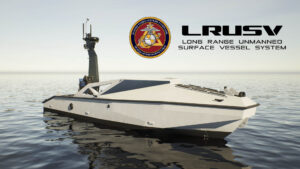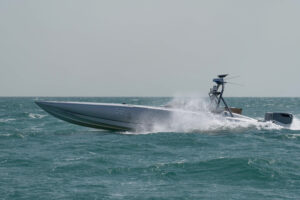The Defense Innovation Unit (DIU) posted a new solicitation on Monday for affordable production-ready small Unmanned Surface Vehicles (sUSVs) that would hunt for targets and explode on contact.
The notice said the Defense Department aims to “swiftly prototype and demonstrate one or more sUSV interceptors” to manufacture and deliver them at scale.

The project is called Production-Ready, Inexpensive, Maritime Expeditionary (PRIME) Small Unmanned Surface Vehicle (sUSV) along with an associated collaborative intercept capability.
DIU said the Navy has a need for small USV interceptors that can autonomously transit for hundreds of miles through contested waterspace, and loiter in an assigned area while monitoring for maritime surface threats. The interceptors would then sprint to hit and explode on contact with a “noncooperative, maneuvering vessel.” Proposals are due by Feb. 12.
It also wants the sUSV interceptors to “seamlessly cooperate in groups” with the solicitation calling for solutions for dynamic multi-agent optimization and unmanned systems collaboration via software and/or hardware. DIU said this means it wants to allow a group of sUSV interceptors to coordinate movement and behaviors during shared tasks, executing complex autonomous behaviors to adapt to a target vessel’s evasive movements.
This is separate from Navy efforts to be able to fire missiles off of USVs. In October, the Navy’s Task Force 59 in the Persian Gulf for the first time test fired the lethal Miniature Aerial Missile System from the MARTAC T38 Devil Ray USV, scoring direct hits. The Navy intends to ultimately procure Large Unmanned Surface Vehicles to be used, among other things, as adjunct magazines that can fire missiles (Defense Daily, Nov. 2, 2023).
This solicitation also comes in the wake of Ukraine developing and deploying secret USVs designed to destroy Russian targets via onboard explosives. Last summer, CNN published an article providing some details of the Ukrainian drones, built domestically, with explosive payloads up to 661 pounds and ranges of up to 500 miles.
This notice comes a month after the Pentagon said Deputy Defense Secretary Kathleen Hicks would soon pick candidates for her Replicator initiative (Defense Daily, Dec. 21, 2023).
Replicator, announced last August, looks to field thousands of all-domain attritable autonomous systems within 18 to 24 months to help overcome China’s advantage in mass and numbers of systems.
Once reviews and evaluations are finished for this DIU solicitation, DoD intends to recommend specific pairing arrangements between selected solutions with their collaborative multi-agent autonomy solutions.
DIU said submissions should have detailed information on five primary focus attributes including production readiness, vehicle performance, sense-and-avoid, autonomous intercept and acceptance of the collaborative multi-agent autonomy solutions.
The sUSV providers must be able to produce at least 10 vehicles per month and 120 or more vehicles per year, starting in spring 2025.

The notice said that solutions have to demonstrate a diverse and resilient manufacturing supply chain “for key components such as hull, propulsion and steering, electric power, sensors, and compute, with the ability to justify production readiness and to elucidate supply chain risk areas.”
DoD wants these vehicles to have a 500 to 1,000 nautical mile range in moderate sea states while transporting a payload up to 1,000 pounds and use diesel fuel. At low sea states, DoD wants the vehicles to “sprint” at 35 knots or more.
“Highly desired” secondary attributes that DIU would like from respondents include solutions that can carry a readily deployed sUAS to help search for and localize vessels of interest and other support missions; automatically adjust emissions control posture when near specific areas or vehicles, particularly to help it shadow and intercept a vehicle of interest without being detected; diversified and adaptive communications resilient to jamming; and report with high accuracy the tracks of vessels of interest to an operations center with minimal false positives.
DIU lists tertiary desired attributes like automated contact recognition to identify various types of surface vessels; the ability to accept a variety of modular payloads, sensors and effectors; flexibility with a variety of launch and recovery methods including amphibious ship well decks, boat ramps and easily transported by land, sea and/or air.
The notice said partnerships and teaming arrangements are encouraged for the sUSV interceptor solutions.
This aims “to allow for the strengths and specializations of individual companies to be integrated toward a complete and compelling vehicle that is production-ready, inexpensive, and operationally effective. For instance, established marine craft manufacturers with active, resilient, high-throughput production lines are invited to partner with companies that develop and integrate the multimodal sensors, compute, and platform autonomy required to create a sUSV.”
DIU said the department may give preference to companies that can provide evidence demonstrating capability in relevant or representative environments and that can show experience in successfully fielding solutions into operations.
The startup company Saronic, is one possible competitor. Founded in 2022, it held a $55 million seed funding round last October (Defense Daily, Oct. 10, 2023).
The company has worked on three autonomous USVs that can operate alone or in swarms, with an eye to GPS and communications-denied environments in any conflict with China. Saronic at the time said it was already ready to participate in the Replicator initiative despite its young age, The company said it can scale up production relatively quickly.